
|
Now it is so bright as 7.6 mag (Oct. 30, Chris Wyatt). It is observable in excellent condition in the Southern Hemisphere. In the Northern Hemisphere, it locates too low to observe in November. It will be observable in the evening low sky in December and January.
Date(TT) R.A. (2000) Decl. Delta r Elong. m1 Best Time(A, h)
Nov. 1 6 3.04 -49 17.5 0.953 1.493 100 7.3 3:25 ( 0, 76)
Nov. 8 4 37.13 -55 17.3 0.989 1.570 104 7.5 1:34 ( 0, 70)
|
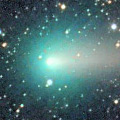
|
The brightness evolution has slowed down just before the perihelion passage. But it brightened up to 6.5 mag in September (Sept. 21, Marco Goiato). Now it is fading, but bright as 10.6 mag still now (Oct. 21, Chris Wyatt). It will be unobservable soon also in the Southern Hemisphere. After this, it will be observable again in late December in the Northern Hemisphere, or in mid January in the Southern Hemisphere. But the comet will fade down to 13 mag.
Date(TT) R.A. (2000) Decl. Delta r Elong. m1 Best Time(A, h)
Nov. 1 15 40.56 -14 3.6 1.826 0.941 18 10.2 20:02 ( 69, -4)
Nov. 8 15 44.52 -12 34.7 1.983 1.045 13 10.6 20:11 ( 65,-12)
|
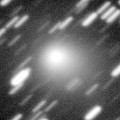
|
Now it is bright as 10.2 mag (Oct. 30, Chris Wyatt). It will approach to the earth in December and January, and it is expected to brighten up to 7 mag. In the Southern Hemisphere, it keeps observable in excellent condition until late January. In the Northern Hemisphere, it keeps extremely low until mid December. But after that, it will be observable in excellent condition.
Date(TT) R.A. (2000) Decl. Delta r Elong. m1 Best Time(A, h)
Nov. 1 8 4.73 -43 47.7 1.667 1.842 83 11.3 3:25 (300, 65)
Nov. 8 8 4.08 -44 11.7 1.528 1.774 86 10.9 3:16 (303, 69)
|
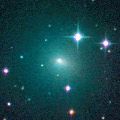
|
It brightened rapidly. Now it is so bright as 10.7 mag (Oct. 30, Neil Norman). In the Northern Hemisphere, it keeps observable in good condition until the comet will fade out in next spring. It is not observable in the Southern Hemisphere.
Date(TT) R.A. (2000) Decl. Delta r Elong. m1 Best Time(A, h)
Nov. 1 9 9.78 78 28.1 1.149 1.664 101 11.4 3:25 (189,-26)
Nov. 8 13 4.48 83 25.7 1.155 1.654 100 11.2 3:16 (188,-36)
|
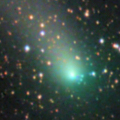
|
The brightness evolution had been slow, and has slowed down furthermore before the perihelion passage. It brightened up to 9.4 mag in September (Sept. 18, Chris Wyatt). However, it is already fading. It has already faded down to 11.6 mag (Oct. 26, Todd Augustyniak). It will be unobservable in early November in the Southern Hemisphere, or in late November in the Northern Hemisphere. In the Northern Hemisphere, it will be observable in excellent condition after January while the comet will be fading.
Date(TT) R.A. (2000) Decl. Delta r Elong. m1 Best Time(A, h)
Nov. 1 17 38.04 -18 41.7 1.883 1.402 46 11.3 20:02 ( 82, 21)
Nov. 8 17 39.39 -15 50.7 2.015 1.413 40 11.5 20:11 ( 80, 13)
|
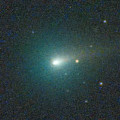
|
Now it is so bright as 10.8 mag (Oct. 28, Mike Wolle). It keeps observable in the morning low sky at the same brightness for a while. In the Southern Hemisphere, it is too low to observe until December.
Date(TT) R.A. (2000) Decl. Delta r Elong. m1 Best Time(A, h)
Nov. 1 11 44.72 6 38.9 1.888 1.372 44 11.9 3:25 (262, 0)
Nov. 8 12 10.17 4 31.2 1.861 1.356 44 11.8 3:16 (264, 0)
|
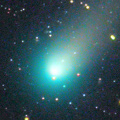
|
It brightened rapidly in outburst in mid October in 2013. Now it is fading. It has already faded down to 13.0 mag (Oct. 18, Con Stoitsis). In the Southern Hemisphere, it keeps observable in good condition for a long time until the comet fades out. In the Northern Hemisphere, it keeps extremely low after this.
Date(TT) R.A. (2000) Decl. Delta r Elong. m1 Best Time(A, h)
Nov. 1 21 46.79 -48 23.8 3.289 3.478 92 12.6 20:02 ( 34, 73)
Nov. 8 21 51.72 -47 36.8 3.443 3.544 87 12.8 20:11 ( 46, 69)
|
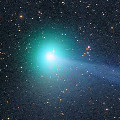
|
It brightened up to 6.0 mag from July to August (July 24, Maik Meyer). Now it is fading. It has already faded down to 12.0 mag (Oct. 25, Seiichi Yoshida). It keeps observable in good condition until November in the Southern Hemisphere, or December in the Northern Hemisphere.
Date(TT) R.A. (2000) Decl. Delta r Elong. m1 Best Time(A, h)
Nov. 1 19 14.74 0 30.3 2.290 2.221 73 13.0 20:02 (114, 30)
Nov. 8 19 18.26 -0 35.6 2.506 2.316 67 13.5 20:11 (107, 24)
|
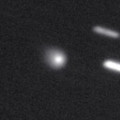
|
Now it is 14.3 mag (Oct. 25, Seiichi Yoshida). Getting brighter than originally expected, and it is already visible visually. It is expected to brighten up to 4 mag from autumn to winter in 2015. It is observable in good condition in the Southern Hemisphere until the highlight, or in the Northern Hemisphere after the highlight.
Date(TT) R.A. (2000) Decl. Delta r Elong. m1 Best Time(A, h)
Nov. 1 22 36.42 -25 23.9 4.621 5.076 111 13.9 20:02 (169, 80)
Nov. 8 22 32.17 -25 34.8 4.670 5.007 104 13.8 20:11 (129, 76)
|

|
New outburst occured on Sept. 30, and it brightened up to 13 mag (Sept. 30, Jean-Francois Soulier). It is already unobservable in the Northern Hemisphere. It will be unobservable soon also in the Southern Hemisphere.
Date(TT) R.A. (2000) Decl. Delta r Elong. m1 Best Time(A, h)
Nov. 1 16 9.27 -28 25.6 6.954 6.098 28 14.1 20:02 ( 62, 10)
Nov. 8 16 15.18 -28 35.2 6.998 6.097 22 14.1 20:11 ( 58, 4)
|

|
Big asteroid discovered in 1906. It suddenly showed the cometary activity on Dec. 11, 2010, probably due to an impact of a small object. It has already turned to be stellar.
Date(TT) R.A. (2000) Decl. Delta r Elong. m1 Best Time(A, h)
Nov. 1 4 50.62 20 7.8 2.551 3.408 144 14.2 2:11 (180, 35)
Nov. 8 4 45.90 20 17.4 2.498 3.408 152 14.1 1:39 (180, 35)
|
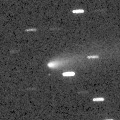
|
Now it is 14.0 mag (Oct. 26, Todd Augustyniak). It is fainter than originally predicted by 2 mag. In the Northern Hemisphere, it keeps observable at 14 mag in excellent condition from 2014 summer to 2015 spring. It locates somewhat low in the Southern Hemisphere.
Date(TT) R.A. (2000) Decl. Delta r Elong. m1 Best Time(A, h)
Nov. 1 10 3.44 20 50.5 2.059 2.005 72 14.2 3:25 (235, 11)
Nov. 8 10 17.94 20 7.1 1.998 2.011 76 14.1 3:16 (235, 12)
|
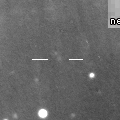
|
It will brighten up to 8-9 mag in 2015 spring. But it is not observable now. In the Southern Hemisphere, it will become observable in January, then it keeps observable in good condition after that. In the Northern Hemisphere, it keeps extremely low and hard to observe from December to 2015 June. It will be observable in good condition after June while the comet will be fading gradually.
Date(TT) R.A. (2000) Decl. Delta r Elong. m1 Best Time(A, h)
Nov. 1 13 49.77 -9 35.5 3.060 2.087 9 14.6 3:25 (294,-15)
Nov. 8 14 4.59 -11 3.3 2.997 2.041 12 14.4 3:16 (294,-13)
|
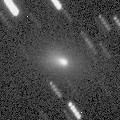
|
Now it is 13.8 mag (Oct. 28, Sandor Szabo). It will be observable at 14.5 mag in excellent condition from October to December.
Date(TT) R.A. (2000) Decl. Delta r Elong. m1 Best Time(A, h)
Nov. 1 5 29.59 25 44.3 0.861 1.714 135 14.5 2:50 (180, 29)
Nov. 8 5 31.73 27 38.0 0.831 1.720 141 14.5 2:25 (180, 27)
|
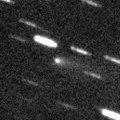
|
Now it is 14.3 mag and visible visually (Oct. 25, Seiichi Yoshida). It keeps observable for a long time after this while the comet will be fading gradually.
Date(TT) R.A. (2000) Decl. Delta r Elong. m1 Best Time(A, h)
Nov. 1 9 30.50 5 26.3 2.257 2.223 75 14.6 3:25 (241, 27)
Nov. 8 9 38.35 4 28.0 2.214 2.264 80 14.7 3:16 (239, 30)
|
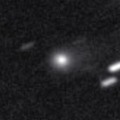
|
Now it is 14.8 mag (Sept. 16, Taras Prystavski). It is expected to brighten up to 13 mag and to be observable in good condition in 2015. It becomes unobservable temporarily from October to January.
Date(TT) R.A. (2000) Decl. Delta r Elong. m1 Best Time(A, h)
Nov. 1 15 28.62 -10 2.0 4.687 3.745 16 14.6 20:02 ( 71, -9)
Nov. 8 15 38.40 -10 36.6 4.681 3.721 12 14.6 20:11 ( 66,-14)
|

|
Now it is 13.5 mag (Oct. 25, Seiichi Yoshida). It keeps bright as 13-14 mag for a long time from 2013 to 2014.
Date(TT) R.A. (2000) Decl. Delta r Elong. m1 Best Time(A, h)
Nov. 1 20 47.55 -27 16.8 3.103 3.236 88 14.6 20:02 ( 99, 64)
Nov. 8 20 53.72 -26 36.9 3.211 3.247 83 14.7 20:11 ( 95, 58)
|
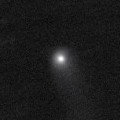
|
Now it is 14.4 mag (Oct. 27, Sandor Szabo). It keeps 15 mag for a long time from 2014 to 2015. It is observable in excellent condition in 2014 in the Southern Hemisphere, or in 2015 in the Northern Hemisphere.
Date(TT) R.A. (2000) Decl. Delta r Elong. m1 Best Time(A, h)
Nov. 1 0 33.03 -31 21.1 3.371 4.049 127 14.7 21:50 (180, 86)
Nov. 8 0 26.71 -29 56.5 3.419 4.032 122 14.7 21:16 (180, 85)
|
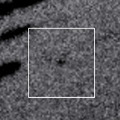
|
Now it is 17.5 mag (Oct. 8, Taras Prystavski). It will brighten very rapidly, up to 10 mag in January. In the Northern Hemisphere, it will be geting higher gradually. In the Southern Hemisphere, it will be getting lower gradually, and it keeps extremely low after January.
Date(TT) R.A. (2000) Decl. Delta r Elong. m1 Best Time(A, h)
Nov. 1 17 33.44 -28 5.6 1.729 1.262 46 15.5 20:02 ( 72, 25)
Nov. 8 17 57.48 -27 57.0 1.694 1.204 44 14.8 20:11 ( 71, 23)
|
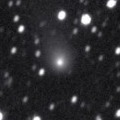
|
Now it is 14.2 mag (Oct. 4, Jakub Cerny). It keeps 13-14 mag and observable in good condition in the Northern Hemisphere for a long time from 2013 to 2014. It locates low in the Southern Hemisphere. Fragment B is also visible at 19-20 mag.
Date(TT) R.A. (2000) Decl. Delta r Elong. m1 Best Time(A, h)
Nov. 1 22 42.04 32 49.3 3.781 4.445 126 14.9 20:02 (179, 22)
Nov. 8 22 38.64 30 29.4 3.891 4.483 121 15.0 20:11 (170, 24)
|

|
Now it is 13.3 mag (Sept. 22, Seiichi Yoshida). It keeps bright at 13-14 mag for a long time until 2014.
Date(TT) R.A. (2000) Decl. Delta r Elong. m1 Best Time(A, h)
Nov. 1 18 21.75 -11 38.2 7.440 6.964 57 15.0 20:02 ( 94, 27)
Nov. 8 18 23.15 -12 8.3 7.565 6.989 51 15.1 20:11 ( 89, 20)
|
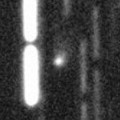
|
Now it is 16.5 mag (Sept. 28, Taras Prystavski). It keeps 14-15 mag for a long time from 2014 autumn to 2015 autumn. In the Southern Hemisphere, it keeps observable in excellent condition for a long time. In the Northern Hemisphere, it is only observable in the low sky from September to October. Then it will be unobservable until 2015 June.
Date(TT) R.A. (2000) Decl. Delta r Elong. m1 Best Time(A, h)
Nov. 1 9 22.68 -41 23.7 2.615 2.452 69 15.2 3:25 (295, 51)
Nov. 8 9 20.92 -45 45.7 2.498 2.407 73 15.0 3:16 (302, 55)
|

|
It brightened up to 11-12 mag in 2012. It has already faded down to 14.9 mag (Aug. 12, Taras Prystavski). Appearing in the morning sky again. It will be observable at 15 mag in good condition again in 2015.
Date(TT) R.A. (2000) Decl. Delta r Elong. m1 Best Time(A, h)
Nov. 1 12 7.57 -9 13.2 9.241 8.432 33 15.1 3:25 (278, 5)
Nov. 8 12 8.52 -9 27.3 9.202 8.469 40 15.1 3:16 (276, 8)
|
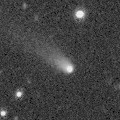
|
Now it is 14.4 mag (Oct. 20, J. Gonzalez). It will be observable at 14 mag in excellent condition in winter.
Date(TT) R.A. (2000) Decl. Delta r Elong. m1 Best Time(A, h)
Nov. 1 22 23.50 -16 22.4 0.903 1.584 113 15.3 20:02 (165, 71)
Nov. 8 22 28.38 -14 49.7 0.918 1.545 107 15.1 20:11 (147, 66)
|
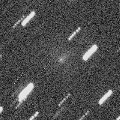
|
Now it is 15.5 mag (Oct. 28, Sandor Szabo). It keeps 15 mag from autumn to winter. It moves southwards fast in winter.
Date(TT) R.A. (2000) Decl. Delta r Elong. m1 Best Time(A, h)
Nov. 1 9 12.55 10 58.4 1.690 1.823 81 15.2 3:25 (233, 26)
Nov. 8 9 20.84 6 59.3 1.630 1.832 84 15.2 3:16 (234, 31)
|
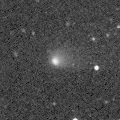
|
It is bright as 14.1 mag still now (Oct. 25, Seiichi Yoshida). It will be fading after this. But it keeps observable until March when it becomes fainter than 18 mag.
Date(TT) R.A. (2000) Decl. Delta r Elong. m1 Best Time(A, h)
Nov. 1 23 28.70 -16 10.1 1.588 2.327 127 15.3 20:46 (180, 71)
Nov. 8 23 31.25 -15 52.3 1.665 2.336 121 15.5 20:21 (180, 71)
|
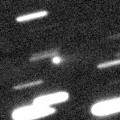
|
Now it is 16.0 mag (Oct. 24, C. Bell). It will brighten up to 15 mag and will be observable in excellent condition from November to February in the Northern Hemisphere. It locates somewhat low in the Southern Hemisphere.
Date(TT) R.A. (2000) Decl. Delta r Elong. m1 Best Time(A, h)
Nov. 1 7 2.80 29 17.2 1.913 2.492 114 15.6 3:25 (194, 24)
Nov. 8 7 5.95 28 58.9 1.832 2.487 120 15.4 3:16 (190, 25)
|
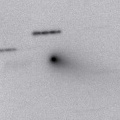
|
Now it is 14.7 mag (Oct. 27, Sandor Szabo). It will be fading after this. But it keeps observable in good condition until February when the comet will be fainter than 18 mag.
Date(TT) R.A. (2000) Decl. Delta r Elong. m1 Best Time(A, h)
Nov. 1 23 47.41 -6 57.7 1.633 2.445 135 15.4 21:05 (180, 62)
Nov. 8 23 49.43 -6 44.7 1.720 2.471 129 15.6 20:40 (180, 62)
|
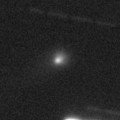
|
Now it is 15.4 mag (Oct. 28, Sandor Szabo). It will brighten up to 14 mag from 2015 to 2016. It is observable in good condition in the Southern Hemisphere. It locates somewhat low in the Northern Hemisphere.
Date(TT) R.A. (2000) Decl. Delta r Elong. m1 Best Time(A, h)
Nov. 1 4 53.21 -25 15.9 4.251 4.903 126 15.5 2:14 (180, 80)
Nov. 8 4 43.62 -25 32.1 4.178 4.874 129 15.5 1:37 (180, 80)
|
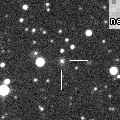
|
Now it is 16.1 mag (Sept. 30, Taras Prystavski). In the Northern Hemisphere, it keeps 15-16 mag and observable in excellent condition for a long time until early summer in 2015. In the Southern Hemisphere, it is not observable until mid January.
Date(TT) R.A. (2000) Decl. Delta r Elong. m1 Best Time(A, h)
Nov. 1 12 6.21 35 50.6 3.906 3.512 59 15.9 3:25 (240,-20)
Nov. 8 12 16.94 35 10.5 3.848 3.515 63 15.9 3:16 (239,-18)
|
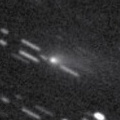
|
It brightened up to 2 mag by unusual major outburst in 2007. It brightened up to 12.6 mag in this apparition (June 25, Taras Prystavski). Now it is fading. It has already faded down to 16.7 mag (Oct. 2, Taras Prystavski). In the Northern Hemisphere, it keeps observable until it fades out in 2015. In the Southern Hemisphere, it keeps extremely low after this.
Date(TT) R.A. (2000) Decl. Delta r Elong. m1 Best Time(A, h)
Nov. 1 5 8.90 50 10.8 1.861 2.621 130 16.0 2:30 (180, 5)
Nov. 8 5 3.29 50 37.4 1.840 2.651 136 16.1 1:57 (180, 4)
|
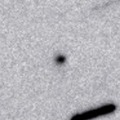
|
Now it is 16.2 mag (Oct. 27, Sandor Szabo). It keeps observable at 15-16 mag for a long time from 2015 to 2016. In the Northern Hemisphere, it is observable in excellent condition. It locates somewhat low in the Southern Hemisphere.
Date(TT) R.A. (2000) Decl. Delta r Elong. m1 Best Time(A, h)
Nov. 1 3 50.30 23 34.7 4.849 5.779 157 16.0 1:11 (180, 31)
Nov. 8 3 45.05 24 6.1 4.793 5.756 165 16.0 0:39 (180, 31)
|
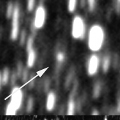
|
Now it is 16.7 mag (Sept. 23, Taras Prystavski). Distant object, but it keeps observable at 14 mag for a long time from 2015 to 2016.
Date(TT) R.A. (2000) Decl. Delta r Elong. m1 Best Time(A, h)
Nov. 1 19 6.45 -6 57.7 6.619 6.342 69 16.1 20:02 (106, 33)
Nov. 8 19 10.17 -7 10.5 6.687 6.313 63 16.1 20:11 (100, 26)
|
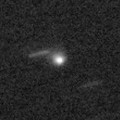
|
It will approach to the sun down to 0.3 a.u. in 2015 July, and it is expected to be bright. Now it is 16.0 mag (Oct. 8, Taras Prystavski). It keeps observable while the comet will be brightening gradually until January when the comet will be 15 mag. The condition is bad after that and it will be hard to observe. But in the Southern Hemisphere, it will be observable after mid July in 2015, and keeps observable while the comet will be fading gradually. In the Northern Hemisphere, it is extremely hard to observe after 2015.
Date(TT) R.A. (2000) Decl. Delta r Elong. m1 Best Time(A, h)
Nov. 1 23 0.16 -29 29.2 3.534 4.045 114 16.3 20:17 (180, 84)
Nov. 8 22 55.63 -29 1.6 3.556 3.963 107 16.2 20:11 (136, 82)
|
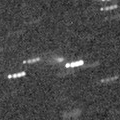
|
First return of a new periodic comet discovered in 2004. Now it is 16.4 mag (Oct. 28, Catalina Sky Survey). It will be observable in excellent condition from autumn to winter. It will brighten very rapidly, and reach up to 16 mag from November to December.
Date(TT) R.A. (2000) Decl. Delta r Elong. m1 Best Time(A, h)
Nov. 1 21 55.40 6 42.2 0.693 1.421 113 16.5 20:02 (163, 47)
Nov. 8 22 12.69 6 11.2 0.707 1.410 111 16.3 20:11 (156, 46)
|
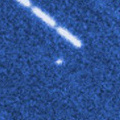
|
Now it is 18.6 mag (Oct. 4, D. Herald). It will brighten up to 9 mag in 2015 spring. But the condition of this apparition is bad. In the Southern Hemisphere, it keeps observable until winter when the comet will be 13 mag. But it is not observable around the brightest days. In the Northern Hemispehre, it keeps extremely low and hard to observe. It will be observable after 2015 autumn when the comet will fade out.
Date(TT) R.A. (2000) Decl. Delta r Elong. m1 Best Time(A, h)
Nov. 1 20 32.53 -48 52.6 2.495 2.533 80 16.6 20:02 ( 50, 62)
Nov. 8 20 40.55 -47 43.7 2.526 2.483 76 16.4 20:11 ( 55, 58)
|
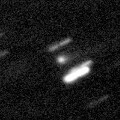
|
Now it is 17.0 mag (Oct. 2, Taras Prystavski). It will brighten up to 16 mag in winter, and will be observable in excellent condition.
Date(TT) R.A. (2000) Decl. Delta r Elong. m1 Best Time(A, h)
Nov. 1 8 20.91 14 47.7 3.885 4.080 94 16.7 3:25 (219, 31)
Nov. 8 8 23.84 14 24.1 3.782 4.079 100 16.7 3:16 (215, 33)
|
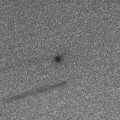
|
Now it is 17.3 mag (Sept. 23, Ken-ichi Kadota). It will brighten up to 16 mag and will be observable in excellent condition in winter.
Date(TT) R.A. (2000) Decl. Delta r Elong. m1 Best Time(A, h)
Nov. 1 10 19.51 11 10.7 2.203 2.009 65 16.8 3:25 (245, 14)
Nov. 8 10 33.41 10 11.9 2.140 2.012 69 16.7 3:16 (245, 16)
|
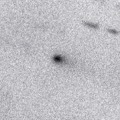
|
It brightened up to 14.6 mag in summer (July 8, Hidetaka Sato). Now it is fading. It has already faded down to 17.8 mag (Sept. 26, Taras Prystavski). It is fading much faster than predicted. The condition is good in the Northern Hemispehre. It keeps observable until next February when the comet will be fainter than 18 mag. It locates somewhat low in the Southern Hemisphere.
Date(TT) R.A. (2000) Decl. Delta r Elong. m1 Best Time(A, h)
Nov. 1 8 32.11 14 24.0 1.790 2.070 91 16.8 3:25 (222, 30)
Nov. 8 8 37.83 13 57.1 1.749 2.114 97 16.8 3:16 (219, 32)
|
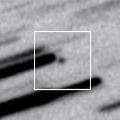
|
Now it is 17.5 mag (Oct. 18, M. Morales). It will pass the perihelion on Mar. 15. In the Northern Hemispehre, it keeps observable in good condition until late February. In the Southern Hemisphere, it keeps observable until mid February, but it locates low.
Date(TT) R.A. (2000) Decl. Delta r Elong. m1 Best Time(A, h)
Nov. 1 5 19.28 39 0.6 1.190 2.012 134 17.2 2:40 (180, 16)
Nov. 8 5 4.94 39 24.3 1.081 1.965 142 16.9 1:59 (180, 16)
|
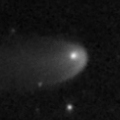
|
Now it is between 15.8 mag (Sept. 3, Taras Prystavski) and 18.5 mag (Sept. 2, M. Jaeger, E. Prosperi, S. Prosperi, W. Vollmann). It brightened up to 13 mag from 2011 to 2012. It will be fading after this, but it keeps brighter than 18 mag until 2015 spring.
Date(TT) R.A. (2000) Decl. Delta r Elong. m1 Best Time(A, h)
Nov. 1 3 38.13 -4 52.5 8.140 9.039 153 17.0 0:59 (180, 60)
Nov. 8 3 34.80 -4 49.0 8.159 9.075 156 17.0 0:28 (180, 60)
|

|
It brightened up to 12-13 mag from 2012 to 2013. Now it is fading. But it is bright as 16.5 mag still now (Oct. 17, Y. Sugiyama). It keeps 16-17 mag until autumn, and will be observable in good condition.
Date(TT) R.A. (2000) Decl. Delta r Elong. m1 Best Time(A, h)
Nov. 1 0 19.65 -18 28.9 3.353 4.118 135 17.0 21:37 (180, 73)
Nov. 8 0 17.06 -18 12.1 3.443 4.134 128 17.1 21:07 (180, 73)
|

|
Now it is 17.6 mag (Oct. 4, L. Arnold). It will pass close to the earth from spring to summer in 2016, and it is expected to be observable at 6-7 mag in good condition. In the Northern Hemispehre, it keeps observable in good condition until 2015 spring when the comet will brighten up to 15.5 mag. In the Southern Hemisphere, it keeps low for a long time until 2016 spring.
Date(TT) R.A. (2000) Decl. Delta r Elong. m1 Best Time(A, h)
Nov. 1 6 53.53 34 22.6 5.715 6.222 116 17.2 3:25 (191, 20)
Nov. 8 6 49.44 34 45.4 5.550 6.161 124 17.1 3:16 (186, 20)
|
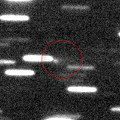
|
Now it is 18.6 mag (Oct. 24, Ken-ichi Kadota). It keeps observable at 17-18 mag from summer to winter in excellent condition in the Northern Hemisphere. It locates somewhat low in the Southern Hemisphere.
Date(TT) R.A. (2000) Decl. Delta r Elong. m1 Best Time(A, h)
Nov. 1 7 10.37 18 11.1 1.899 2.443 111 17.3 3:25 (199, 35)
Nov. 8 7 12.31 18 19.8 1.844 2.470 118 17.3 3:16 (194, 35)
|
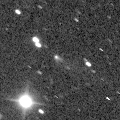
|
Now it is 18.1 mag (Oct. 1, Catalina Sky Survey). It was observed at 17 mag from 2013 to early 2014. It will be observable at 17.5 mag in good condition again from autumn to winter in 2014.
Date(TT) R.A. (2000) Decl. Delta r Elong. m1 Best Time(A, h)
Nov. 1 8 31.64 14 53.6 3.038 3.225 91 17.5 3:25 (221, 29)
Nov. 8 8 35.59 14 25.3 2.952 3.237 97 17.5 3:16 (218, 32)
|
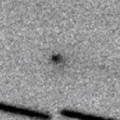
|
Now it is 17.0 mag (Sept. 20, Ken-ichi Kadota). It keeps observable at 17-18 mag from August to November in excellent condition in the Northern Hemisphere. It locates somewhat low in the Southern Hemisphere.
Date(TT) R.A. (2000) Decl. Delta r Elong. m1 Best Time(A, h)
Nov. 1 7 54.47 22 7.3 1.027 1.569 101 17.5 3:25 (209, 27)
Nov. 8 8 3.23 22 4.1 1.006 1.605 106 17.7 3:16 (206, 28)
|
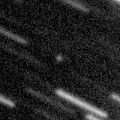
|
Peculiar asteroid with a cometary orbit of 45-years period. Now it is 18.3 mag (Oct. 4, M. Jaeger, et al.). It will brighten up to 17 mag from November to December, and will be observable in excellent condition.
Date(TT) R.A. (2000) Decl. Delta r Elong. m1 Best Time(A, h)
Nov. 1 5 50.67 25 12.8 1.971 2.721 130 17.7 3:12 (180, 30)
Nov. 8 5 31.18 22 53.9 1.880 2.729 141 17.5 2:25 (180, 32)
|
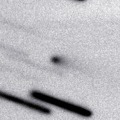
|
It brightened up to 15.5 mag in summer (July 28, Ken-ichi Kadota). Now it is fading. It has already faded down to 17.6 mag (Oct. 22, Catalina Sky Survey). In the Northern Hemisphere, it keeps observable in good condition until the comet fades out. In the Southern Hemisphere, it keeps extremely low.
Date(TT) R.A. (2000) Decl. Delta r Elong. m1 Best Time(A, h)
Nov. 1 9 39.83 32 43.9 1.732 1.879 82 17.5 3:25 (223, 6)
Nov. 8 9 53.35 33 9.7 1.703 1.918 86 17.7 3:16 (222, 6)
|

|
Now it is 18.3 mag (Oct. 19, A. Diepvens). It will brighten up to 13 mag in 2016. In the Northern Hemisphere, it will be observable at 16 mag in excellent condition in this winter. It locates somewhat low in the Southern Hemisphere.
Date(TT) R.A. (2000) Decl. Delta r Elong. m1 Best Time(A, h)
Nov. 1 6 42.74 26 59.8 2.840 3.429 118 17.7 3:25 (190, 27)
Nov. 8 6 42.69 27 9.7 2.730 3.404 125 17.6 3:16 (185, 28)
|
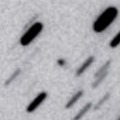
|
Now it is 17.6 mag (Oct. 24, Ken-ichi Kadota). It was observed around 17-18 mag in early 2014. It will be observable around 17-18 mag again from 2014 autumn to 2015 spring, in excellent condition in the Northern Hemisphere. It is not observable in the Southern Hemisphere.
Date(TT) R.A. (2000) Decl. Delta r Elong. m1 Best Time(A, h)
Nov. 1 10 28.99 53 45.8 5.119 5.117 84 17.6 3:25 (214,-15)
Nov. 8 10 35.63 53 48.6 5.042 5.118 88 17.6 3:16 (213,-14)
|
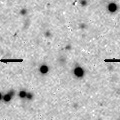
|
Now it is 17.7 mag (Sept. 28, Toshiyuki Takahashi). It keeps observable at 17-18 mag in good condition from July to October.
Date(TT) R.A. (2000) Decl. Delta r Elong. m1 Best Time(A, h)
Nov. 1 22 3.10 -11 30.5 1.964 2.492 110 17.9 20:02 (156, 65)
Nov. 8 22 8.35 -10 42.3 2.049 2.496 104 18.0 20:11 (142, 61)
|
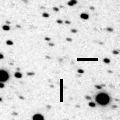
|
It was discovered in 1819, and re-discovered in 2003. Although it was predicted to be extremely faint as 26 mag, it unusually brightened up to 17.5 mag in outburst in 2013 July (July 6, Hidetaka Sato). However, no observations have been reported since mid July. It will pass the perihelion in 2014 August, and will approach to the sun down to 0.96 a.u. The brightness is predicted to be 23 mag at best. However, if the cometary activity continues, it may be observed brighter. Ken-ichi Kadota reported it was not detected, fainter than 16.3 mag, on May 21.
Date(TT) R.A. (2000) Decl. Delta r Elong. m1 Best Time(A, h)
Nov. 1 11 59.90 4 22.7 1.906 1.315 40 23.8 3:25 (266, -1)
Nov. 8 12 17.69 2 38.3 1.934 1.377 42 23.9 3:16 (267, 0)
|
|
![]()
 C/2013 U2 ( Holvorcem )
C/2013 U2 ( Holvorcem ) 303P/2014 L1 ( NEAT )
303P/2014 L1 ( NEAT ) 289P/Blanpain
289P/Blanpain![]()


















































